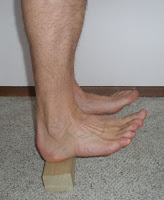We
all hopefully like to keep in shape, or at least try to. However, in our chase of perfect health a lot
of times we injure ourselves further.
Runners and Joggers in particular are highly susceptible to leg injuries
that take place over time that you can be unaware of until it is too late. Here are a few simple warm up exercises that
help prevent well know injuries that runners can become susceptible to.
Exercise
1: Heel Walking & Big toe Raisers
This
exercise helps to prevent shin splints.
Shin splints are one of the more common types of injuries runners can
have. They are acute pains in the shin and lower leg caused by prolonged
running, typically on hard surfaces.
Exercise
2: Calf Drops
This
exercise helps to prevent Achilles tendinitis. Achilles tendinitis is when the Achilles
tendon becomes swollen, inflamed, and painful at the heel.
Exercise
3: Arch Raisers
This
exercise helps to prevent plantar fasciitis. Plantar Fasciitis is inflammation of the
thick tissue on the bottom of the foot.
Exercise
4: Side Leg Raisers
This
exercise helps to prevent IT Band Syndrome. Iliotibial band syndrome is a common injury
to the knee, generally associated with running.
It causes symptoms such as knee pain and tenderness when walking,
running or using stairs.
Exercise
5: Half Squats on a Downward Slope
This
exercise helps to prevent runner’s knee.
As the name states, runner’s knee is a very common ailment for runners
and refers to the progressive erosion of the articular cartilage of the knee
joint.
With
these five warm up exercises you can save yourself from potentially bad
injuries and make sure your running helps to maintain a healthy and
prolonged life.
If
you're looking for professional experienced high-rated orthopedic surgeons in
South Florida, contact Sea Spine Orthopedic Institute today with any
questions
at 866-816-ORTHO.
Like us on Facebook
Follow us on Twitter
at 866-816-ORTHO.
Like us on Facebook
Follow us on Twitter










